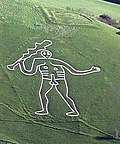There are more than 1000 scheduled monuments in the county of Dorset, in South West England. These protected sites date from the Neolithic period and include barrows, stone circles, hill figures, ancient Roman sites, castle ruins, and medieval abbeys.[1]In the United Kingdom, the scheduling of monuments was first initiated to ensure the preservation of "nationally important" archaeological sites or historic buildings. Protection is given to scheduled monuments under the Ancient Monuments and Archaeological Areas Act 1979.[2]
Notable scheduled monuments in Dorset
| Image | Name | Location | Date | Notes |
|---|---|---|---|---|
 | Abbotsbury Abbey | Abbotsbury | 11th century | Benedictine Monastery dedicated to St Peter.y[3] |
 | Cerne Abbas Giant | Cerne Abbas | Unknown | 55 metres (180 ft) high Hill figure of a standing, nude man holding a club.[4] |
 | Corfe Castle | Corfe Castle | 11th century | Ruined castle originally built by William the Conqueror[5] |
 | Dorset Cursus | Cranborne Chase | 3300 BCE | Neolithic cursus. This may be Britain's largest Neolithic site. It spans six miles (10km) through the chalk downs of Cranborne Chase.[6] |
 | Kingston Russell Stone Circle | Between Abbotsbury and Littlebredy | 3300—900 BCE. | This stone circle is the largest of those in Dorset, measuring 24 by 27 m (79 feet by 89 feet) in diameter and containing eighteen sarsen stones.[7] |
 | Lulworth Castle | Cranborne Chase | Early 17th century | Early 17th century hunting lodge built in the style of a revival fortified castle.[8] |
 | Maiden Castle, Dorset | Dorchester | 800 BCE – 43 AD | Maiden Castle is one of the largest Iron Age hillforts in Britain.[9] |
 | Nine Stones, Winterbourne Abbas | Winterbourne Abbas | 3300 BCE – 900 BCE | Bronze Age stone circle.[10] |
 | St Martin's Church, Wareham | Wareham | 7th century | Anglo-Saxon Church built by St Aldhelm. It is the oldest surviving church in Dorset.[11] |
See also
References
🔥 Top keywords: Main PageSpecial:SearchPage 3Wikipedia:Featured picturesHouse of the DragonUEFA Euro 2024Bryson DeChambeauJuneteenthInside Out 2Eid al-AdhaCleopatraDeaths in 2024Merrily We Roll Along (musical)Jonathan GroffJude Bellingham.xxx77th Tony AwardsBridgertonGary PlauchéKylian MbappéDaniel RadcliffeUEFA European Championship2024 ICC Men's T20 World CupUnit 731The Boys (TV series)Rory McIlroyN'Golo KantéUEFA Euro 2020YouTubeRomelu LukakuOpinion polling for the 2024 United Kingdom general electionThe Boys season 4Romania national football teamNicola CoughlanStereophonic (play)Gene WilderErin DarkeAntoine GriezmannProject 2025